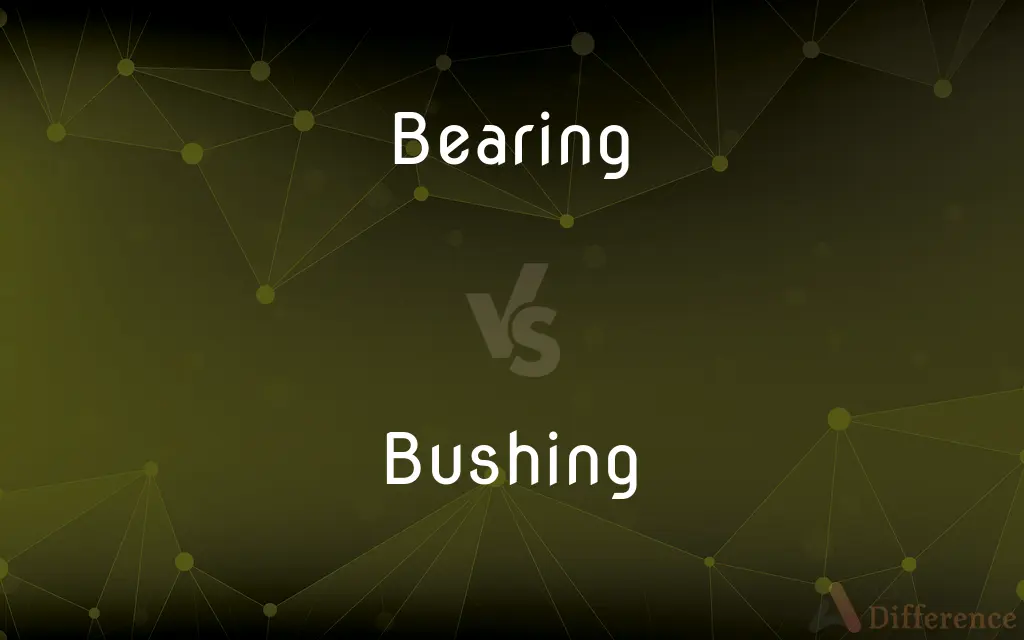Bearing vs. Bushing — What's the Difference?
Edited by Tayyaba Rehman — By Urooj Arif — Updated on April 16, 2024
Bearing assists precise rotation between machine parts, using rolling elements, whereas a bushing provides a sliding surface without rolling elements.

Difference Between Bearing and Bushing
Table of Contents
ADVERTISEMENT
Key Differences
Bearings are designed to handle both radial and axial loads, allowing parts to rotate with minimal friction. This functionality is achieved through the use of balls or rollers. On the other hand, bushings, which are typically simpler, handle mostly radial loads through a sliding motion provided by a lubricated surface.
The structure of a bearing is more complex, incorporating rolling elements such as balls or rollers encased between inner and outer rings. This design reduces the contact area, minimizing friction and wear. Whereas bushings are generally simpler, consisting of a single sleeve of metal or other materials, which operates by sliding over the moving surface.
Bearings are often made from steel or ceramic materials to withstand the high forces and speeds they encounter in machinery. Bushings, however, are made from a broader range of materials including bronze, plastic, and rubber, depending on the application's demand for durability, resistance, and cost-effectiveness.
The maintenance requirements for bearings are higher due to their complex assembly and the need for precise alignment and lubrication. Bushings are comparatively low maintenance, often requiring only occasional lubrication to prevent wear and ensure smooth operation.
Bearings are suitable for applications that involve high-speed operation and heavy loads, such as in automotive and industrial machinery. Bushings are more commonly found in applications where loads are lighter and speeds are lower, such as in office machinery and household appliances.
ADVERTISEMENT
Comparison Chart
Function
Facilitates precise rotation with rolling elements
Provides sliding motion without rolling elements
Load Handling
Radial and axial loads
Primarily radial loads
Structure
Complex with inner and outer rings and rolling elements
Simple, usually a single sleeve
Material
Steel, ceramic
Bronze, plastic, rubber
Application
High-speed, heavy-load machinery
Lower-speed, lighter-load applications
Compare with Definitions
Bearing
A machine element that constrains relative motion to only the desired motion, reducing friction between moving parts.
The engine's performance is highly dependent on the condition of its bearings.
Bushing
A simple component that provides a bearing surface for rotary applications.
The motor's bushing was lubricated to enhance its performance.
Bearing
An element used in various applications to ensure the free rotation of parts without transmitting forces.
Bearings in the conveyor belt help facilitate smooth movement of goods.
Bushing
A machine part made of soft material to permit the relative motion by sliding, as opposed to rolling.
The bushing allows the bicycle pedal to move freely.
Bearing
A component used to fix and guide the rotating assembly of the wheels to the body of the automobile.
A faulty bearing can cause a loud rumbling noise when the car is turning.
Bushing
A type of bearing, a cylindrical lining designed to reduce friction and wear inside a hole, often used to secure a shaft.
The bushing needs to be replaced to prevent the machine from seizing up.
Bearing
A precision part that helps in the reduction of rotational friction and support radial and axial loads.
Replacing worn bearings can greatly improve machine efficiency.
Bushing
A removable lining piece that mainly handles radial loads in various mechanical assemblies.
Bushings are often found in clocks and household appliances.
Bearing
The manner in which one carries or conducts oneself
The poise and bearing of a champion.
Bushing
A protective device often made from rubber to isolate vibration and reduce noise.
The suspension bushings were replaced to improve the ride quality of the car.
Bearing
A machine or structural part that supports another part.
Bushing
A fixed or removable cylindrical metal lining used to constrain, guide, or reduce friction.
Bearing
A device that supports, guides, and reduces the friction of motion between fixed and moving machine parts.
Bushing
(Electricity) An insulating lining for an aperture through which a conductor passes.
Bearing
Something that supports weight.
Bushing
An adapter threaded to permit joining of pipes with different diameters.
Bearing
The part of an arch or beam that rests on a support.
Bushing
(mechanical engineering) A type of bearing, a cylindrical lining designed to reduce friction and wear inside a hole, often used as a casing for a shaft, pin or hinge.
Bearing
The act, power, or period of producing fruit or offspring.
Bushing
(mechanical engineering) An elastic bearing used as a type of vibration isolator, commonly made of rubber. An interface between two parts, damping the movement and the energy transmitted.
Bearing
The quantity produced; yield.
Bushing
(mechanical engineering) A threaded bushing: a fastener element that is inserted into an object, usually to add a threaded hole in a softer or thin material.
Bearing
Direction, especially angular direction measured from one position to another using geographical or celestial reference lines.
Bushing
(electrical engineering) A lining for an opening through which a conductor passes, providing insulation and mechanical protection for the conductor.
Bearing
Often bearings Awareness of one's position or situation relative to one's surroundings
Lost my bearings after taking the wrong exit.
Bushing
An adapter for joining pipes of different size.
Bearing
Relevant relationship or interconnection
Those issues have no bearing on our situation.
Bushing
Present participle of bush
Bearing
(Heraldry) A charge or device on a field.
Bushing
The operation of fitting bushes, or linings, into holes or places where wear is to be received, or friction diminished, as pivot holes, etc.
Bearing
(Architecture) Designed to support structural weight
A bearing wall.
Bushing
A bush or lining; - sometimes called a thimble. See 4th Bush.
Bearing
Present participle of bear
Bushing
An insulating liner in an opening through which conductors pass
Bearing
(in combination) That bears (some specified thing).
A gift-bearing visitor
Bushing
A cylindrical metal lining used to reduce friction
Bearing
Of a beam, column, or other device, carrying weight or load.
That's a bearing wall.
Bearing
(mechanical engineering) A mechanical device that supports another part and/or reduces friction.
Bearing
The horizontal angle between the direction of an object and another object, or between it and that of true north; a heading or direction.
Bearing
One's understanding of one's orientation or relative position, literally or figuratively.
Do we go left here or straight on? Hold on, let me just get my bearings.
I started a new job last week, and I still haven't quite found my bearings.
Bearing
Relevance; a relationship or connection.
That has no bearing on this issue.
Bearing
One's posture, demeanor, or manner.
She walks with a confident, self-assured bearing.
Bearing
(architecture) That part of any member of a building which rests upon its supports.
A lintel or beam may have four inches of bearing upon the wall.
Bearing
(architecture) The portion of a support on which anything rests.
Bearing
The unsupported span.
The beam has twenty feet of bearing between its supports.
Bearing
(heraldry) Any single emblem or charge in an escutcheon or coat of arms.
Bearing
The manner in which one bears or conducts one's self; mien; behavior; carriage.
I know him by his bearing.
Bearing
Patient endurance; suffering without complaint.
Bearing
The situation of one object, with respect to another, such situation being supposed to have a connection with the object, or influence upon it, or to be influenced by it; hence, relation; connection.
But of this frame, the bearings and the ties,The strong connections, nice dependencies.
Bearing
Purport; meaning; intended significance; aspect.
Bearing
The act, power, or time of producing or giving birth; as, a tree in full bearing; a tree past bearing.
[His mother] in travail of his bearing.
Bearing
That part of any member of a building which rests upon its supports; as, a lintel or beam may have four inches of bearing upon the wall.
Bearing
The part of an axle or shaft in contact with its support, collar, or boxing; the journal.
Bearing
Any single emblem or charge in an escutcheon or coat of arms - commonly in the pl.
A carriage covered with armorial bearings.
Bearing
The situation of a distant object, with regard to a ship's position, as on the bow, on the lee quarter, etc.; the direction or point of the compass in which an object is seen; as, the bearing of the cape was W. N. W.
Bearing
Relevant relation or interconnection;
Those issues have no bearing on our situation
Bearing
The direction or path along which something moves or along which it lies
Bearing
Dignified manner or conduct
Bearing
Characteristic way of bearing one's body;
Stood with good posture
Bearing
Heraldry consisting of a design or image depicted on a shield
Bearing
A rotating support placed between moving parts to allow them to move easily
Bearing
(of a structural member) withstanding a weight or strain
Bearing
Producing or yielding;
An interest-bearing note
Fruit-bearing trees
Common Curiosities
What is the main function of a bearing?
Bearings are designed to facilitate precise rotation and support loads by minimizing friction between moving parts using rolling elements.
What materials are commonly used to make bushings?
Bushings can be made from a variety of materials including bronze, plastic, and rubber, depending on the application's needs.
How do bearings differ from bushings in their structure?
Bearings typically consist of rolling elements between inner and outer rings, whereas bushings are generally simpler with a single sleeve.
Are bushings suitable for high-speed applications?
Bushings are more suited to lower-speed and lighter-load applications, such as in office machinery or electrical appliances.
What is the maintenance requirement for bearings compared to bushings?
Bearings generally require more meticulous maintenance, including precise alignment and lubrication, compared to the simpler maintenance needs of bushings.
Why might one choose a bushing over a bearing?
One might choose a bushing for applications that require simpler, more cost-effective solutions and can operate effectively under lower speeds and loads.
What are the common applications for bearings?
Bearings are commonly used in high-speed and heavy-load applications such as automotive and industrial machinery.
How do I know when a bushing needs to be replaced?
Signs of bushing wear include increased noise, excessive vibration, or decreased movement precision.
Can bushings handle axial loads?
Bushings are primarily designed to handle radial loads, though some specialized types can manage axial loads to a degree.
Can a bushing be used as a bearing?
While bushings can serve similar functions as bearings, they are typically used in different contexts due to their simpler design and material properties.
What preventive measures can extend the life of bearings and bushings?
Regular maintenance, including proper lubrication and cleaning, as well as ensuring correct installation and load conditions, can significantly extend the life of both bearings and bushings.
What causes bearings to fail?
Common causes of bearing failure include improper installation, inadequate lubrication, and excessive load or speed.
How does the material of a bushing affect its performance?
The material of a bushing affects its durability, friction coefficient, and suitability for specific environments and loads.
What types of loads can bearings handle?
Bearings can handle both radial and axial loads, making them versatile in various mechanical setups.
What does it mean when a bearing is described as 'precision'?
A precision bearing is designed for specific tolerances and characteristics suited to high-performance applications requiring minimal friction and wear.
Share Your Discovery

Previous Comparison
Lag vs. Laggy
Next Comparison
Phagocytosis vs. PinocytosisAuthor Spotlight
Written by
Urooj ArifUrooj is a skilled content writer at Ask Difference, known for her exceptional ability to simplify complex topics into engaging and informative content. With a passion for research and a flair for clear, concise writing, she consistently delivers articles that resonate with our diverse audience.
Edited by
Tayyaba RehmanTayyaba Rehman is a distinguished writer, currently serving as a primary contributor to askdifference.com. As a researcher in semantics and etymology, Tayyaba's passion for the complexity of languages and their distinctions has found a perfect home on the platform. Tayyaba delves into the intricacies of language, distinguishing between commonly confused words and phrases, thereby providing clarity for readers worldwide.














































